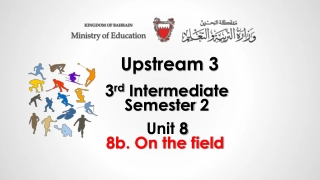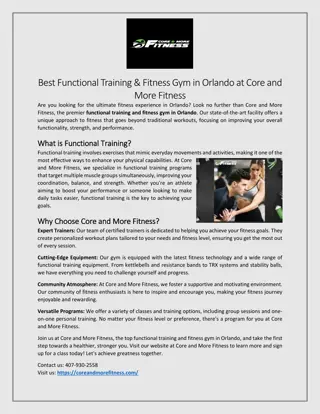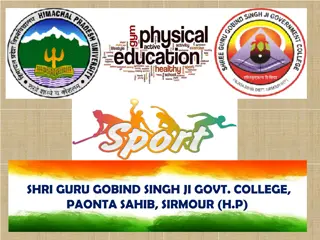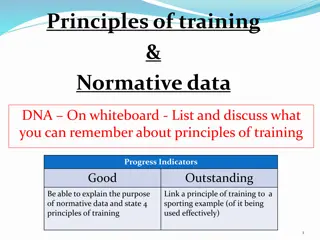Understanding Health-Related and Performance-Related Fitness Components in Sports Science
Distinguishing between health-related and performance-related fitness components is crucial in understanding how fitness impacts success in sports. Health-related factors are physiologically based, influencing an individual's ability to meet physical demands, while skill-related factors are based on the neuromuscular system, impacting specific skill performance. Both dimensions are essential in all activities, with varying importance depending on the sport. This distinction helps in developing tailored training programs for optimal performance.
- Health-related fitness
- Performance-related fitness
- Sporting activities
- Fitness components
- Skill-related factors
Download Presentation

Please find below an Image/Link to download the presentation.
The content on the website is provided AS IS for your information and personal use only. It may not be sold, licensed, or shared on other websites without obtaining consent from the author. Download presentation by click this link. If you encounter any issues during the download, it is possible that the publisher has removed the file from their server.
E N D
Presentation Transcript
IB Sports, exercise and health science Measurement & evaluation of human performance Topic 6 Measurement 6.2.1 Distinguish between the concepts of health- related fitness and performance-related (skill-related) fitness Topic 6 Measurement The components of fitness relate to the requirements of a given sporting activity, and can help to explain success or failure in sport. A distinction can be made between components that are generally considered to be health related (health benefits may be gained through improvements in these components), and those that are skill related, although both will affect performance in sport. Wesson et.al 2005 The components of fitness relate to the requirements of a given sporting activity, and can help to explain success or failure in sport. Sub-topics 1. Statistical Analysis 1. Statistical Analysis 2. Components of fitness A distinction can be made between components that are generally considered to be health related (health benefits may be gained through improvements in these components), and those that are skill related, although both will affect performance in sport. 3. Principles of training programme design Wesson et.al 2005
IB Sports, exercise and health science Measurement & evaluation of human performance Topic 6 Measurement 6.2.1 Distinguish between the concepts of health- related fitness and performance-related (skill-related) fitness Topic 6 Measurement Health related factors are physiologically based and determine the ability of an individual to meet the physical demands of the activity. Skill related factors are based upon the neuromuscular system and determine how successful a person can perform a specific skill. Wesson et.al 2005 Sub-topics Health related factors are physiologically based and determine the ability of an individual to meet the physical demands of the activity. 1. Statistical Analysis 1. Statistical Analysis 2. Components of fitness Skill related factors are based upon the neuromuscular system and determine how successful a person can perform a specific skill. 3. Principles of training programme design Wesson et.al 2005
IB Sports, exercise and health science Measurement & evaluation of human performance Topic 6 Measurement 6.2.1 Distinguish between the concepts of health- related fitness and performance-related (skill-related) fitness Topic 6 Measurement Both health and skill related are required in all activities, but the relative importance of each dimension may differ. For example, a person may be physically suited to tennis, possessing speed, endurance and strength requirements, but may not possess the hand eye coordination to strike the ball successfully. In this instance the individual may be more suited to an activity such as distance running that requires fewer skill related components. Wesson et.al 2005 Both health and skill related are required in all activities, but the relative importance of each dimension may differ. For example, a person may be physically suited to tennis, possessing speed, endurance and strength requirements, but may not possess the hand eye coordination to strike the ball successfully. In this instance the individual may be more suited to an activity such as distance running that requires fewer skill related components. Sub-topics 1. Statistical Analysis 1. Statistical Analysis 2. Components of fitness 3. Principles of training programme design Wesson et.al 2005
IB Sports, exercise and health science Measurement & evaluation of human performance Topic 6 Measurement 6.2.2 Outline the major components of fitness Topic 6 Measurement Strength Relates to the ability of the body to apply a force. The recognised definition of strength is, the maximum force that can be developed in a muscle or group of muscles in a single maximal contraction. Strength Sub-topics 1. Statistical Analysis 1. Statistical Analysis Relates to the ability of the body to apply a force. The recognised definition of strength is, the maximum force that can be developed in a muscle or group of muscles in a single maximal contraction. 2. Components of fitness 3. Principles of training programme design
IB Sports, exercise and health science Measurement & evaluation of human performance Topic 6 Measurement 6.2.2 Outline the major components of fitness Topic 6 Measurement However, it is how we apply strength that is important in the sporting context. Three classifications have been identified: Maximum strength: an athlete who requires a very large force to overcome a resistance in a single contraction e.g. weight lifting Elastic strength (Power): an athlete who requires to overcome resistance rapidly yet prepare the muscle quickly for sequential contraction e.g. sprinting, triple jump Strength endurance: an athlete who is required to undergo repeated contractions and withstand fatigue e.g. rowing, swimming Wesson et.al 2005 However, it is how we apply strength that is important in the sporting context. Three classifications have been identified: Maximum strength: an athlete who requires a very large force to overcome a resistance in a single contraction e.g. weight lifting Elastic strength (Power): an athlete who requires to overcome resistance rapidly yet prepare the muscle quickly for sequential contraction e.g. sprinting, triple jump Strength endurance: an athlete who is required to undergo repeated contractions and withstand fatigue e.g. rowing, swimming Sub-topics 1. Statistical Analysis 1. Statistical Analysis 2. Components of fitness 3. Principles of training programme design Wesson et.al 2005
IB Sports, exercise and health science Measurement & evaluation of human performance Topic 6 Measurement 6.2.2 Outline the major components of fitness Topic 6 Measurement Local Muscle Endurance Is the ability of a particular muscle group to keep working at the desired level of effort for as long as the situation demands. It is often controlled by the body s tolerance of the increasing levels of lactic acid which the activity creates. It is of high importance in: The arms in a 200m swim. The legs in a marathon The arms, abdominals and quadriceps in a 2000m rowing race. Smyth 2nd Ed et.al 2006 Local Muscle Endurance Is the ability of a particular muscle group to keep working at the desired level of effort for as long as the situation demands. It is often controlled by the body s tolerance of the increasing levels of lactic acid which the activity creates. It is of high importance in: The arms in a 200m swim. The legs in a marathon The arms, abdominals and quadriceps in a 2000m rowing race. Sub-topics 1. Statistical Analysis 1. Statistical Analysis 2. Components of fitness 3. Principles of training programme design Smyth 2nd Ed et.al 2006
IB Sports, exercise and health science Measurement & evaluation of human performance Topic 6 Measurement 6.2.2 Outline the major components of fitness Topic 6 Measurement Speed - the ability to put body parts into motion quickly, or the maximum rate that a person can move over a specific distance. It is a major factor in high intensity explosive activities such as sprinting, vaulting in gymnastics or fast bowling in cricket. However, it is not simply concerned with the rate at which a person can move his/her body from A to B. It also involves putting limbs into action rapidly, such as with the throwing of the javelin. It is genetically determined by fast twitch fibre composition, with body mechanics and leverage also playing a role. Wesson et.al 2005 Speed - the ability to put body parts into motion quickly, or the maximum rate that a person can move over a specific distance. It is a major factor in high intensity explosive activities such as sprinting, vaulting in gymnastics or fast bowling in cricket. However, it is not simply concerned with the rate at which a person can move his/her body from A to B. It also involves putting limbs into action rapidly, such as with the throwing of the javelin. It is genetically determined by fast twitch fibre composition, with body mechanics and leverage also playing a role. Sub-topics 1. Statistical Analysis 1. Statistical Analysis 2. Components of fitness 3. Principles of training programme design Wesson et.al 2005
IB Sports, exercise and health science Measurement & evaluation of human performance Topic 6 Measurement 6.2.2 Outline the major components of fitness Topic 6 Measurement Power Is the combination of strength and speed. A powerful movement is achieved quickly as possible, while imparting as much strength as possible. It is of high importance in: Field events Tackling in rugby or football. Spike in volleyball Drive in golf Smyth 2nd Ed et.al 2006 Power Is the combination of strength and speed. A powerful movement is achieved quickly as possible, while imparting as much strength as possible. It is of high importance in: Sub-topics 1. Statistical Analysis 1. Statistical Analysis 2. Components of fitness 3. Principles of training programme design Field events Tackling in rugby or football. Spike in volleyball Drive in golf Smyth 2nd Ed et.al 2006
IB Sports, exercise and health science Measurement & evaluation of human performance Topic 6 Measurement 6.2.2 Outline the major components of fitness Topic 6 Measurement Cardio-respiratory fitness (aerobic capacity) Is dependant upon the ability of the cardiovascular system to transport and utilise oxygen during sustained exercise. It can be defined as: the ability to provide and sustain energy aerobically. Cardio-respiratory endurance is the component of fitness that underpins all aerobic activities which include long distance running , cycling or swimming as well as being a contributing factor to many other sporting situations. Wesson et.al 2005 Cardio-respiratory fitness (aerobic capacity) Is dependant upon the ability of the cardiovascular system to transport and utilise oxygen during sustained exercise. It can be defined as: the ability to provide and sustain energy aerobically. Cardio-respiratory endurance is the component of fitness that underpins all aerobic activities which include long distance running , cycling or swimming as well as being a contributing factor to many other sporting situations. Sub-topics 1. Statistical Analysis 1. Statistical Analysis 2. Components of fitness 3. Principles of training programme design Wesson et.al 2005
IB Sports, exercise and health science Measurement & evaluation of human performance Topic 6 Measurement 6.2.2 Outline the major components of fitness Topic 6 Measurement Flexibility the range of movement at a joint. It is determined by the elasticity of ligaments and tendons, the strength and opposition of surrounding muscles (including antagonists) and the shape of articulating bones. Although it is commonly associated with gymnastics, it is in fact a requirement in all sports since the development of flexibility can lead to both an increase in speed and power of muscle contraction. Wesson et.al 2005 Flexibility the range of movement at a joint. It is determined by the elasticity of ligaments and tendons, the strength and opposition of surrounding muscles (including antagonists) and the shape of articulating bones. Although it is commonly associated with gymnastics, it is in fact a requirement in all sports since the development of flexibility can lead to both an increase in speed and power of muscle contraction. Sub-topics 1. Statistical Analysis 1. Statistical Analysis 2. Components of fitness 3. Principles of training programme design Wesson et.al 2005
IB Sports, exercise and health science Measurement & evaluation of human performance Topic 6 Measurement 6.2.2 Outline the major components of fitness Topic 6 Measurement Body Composition the component parts of the body in terms of the relative amounts of body fat compared to lean body mass. For the average 18 year old, men range from 14-17%, while woman range from 24-29%. For the athlete high body fat can result in a reduction in muscle efficiency and contributes to greater energy expenditure since more weight requires more energy to move around and a consequent increase in oxygen consumption. Wesson et.al 2005 Body Composition the component parts of the body in terms of the relative amounts of body fat compared to lean body mass. For the average 18 year old, men range from 14- 17%, while woman range from 24-29%. For the athlete high body fat can result in a reduction in muscle efficiency and contributes to greater energy expenditure since more weight requires more energy to move around and a consequent increase in oxygen consumption. Sub-topics 1. Statistical Analysis 1. Statistical Analysis 2. Components of fitness 3. Principles of training programme design Wesson et.al 2005
IB Sports, exercise and health science Measurement & evaluation of human performance Topic 6 Measurement 6.2.2 Outline the major components of fitness Topic 6 Measurement Skill/motor fitness Involves the components of fitness that are skill related. These include speed and power, as well as agility, balance, coordination and reaction time. Honeybourne et.al2004 Skill/motor fitness Sub-topics Involves the components of fitness that are skill related. These include speed and power, as well as agility, balance, coordination and reaction time. 1. Statistical Analysis 1. Statistical Analysis 2. Components of fitness 3. Principles of training programme design Honeybourne et.al2004
IB Sports, exercise and health science Measurement & evaluation of human performance Topic 6 Measurement 6.2.2 Outline the major components of fitness Topic 6 Measurement Agility the ability to move and change direction and position of the body quickly and effectively while under control. With reference to this definition we can see that many factors are involved in agility, including balance, coordination, speed and flexibility. It is required in a range of activities from tumbling in gymnastics to receiving balls in volleyball. Although activities can be undertaken to improve agility, development of this skill related component is limited. Wesson et.al 2005 Agility the ability to move and change direction and position of the body quickly and effectively while under control. With reference to this definition we can see that many factors are involved in agility, including balance, coordination, speed and flexibility. It is required in a range of activities from tumbling in gymnastics to receiving balls in volleyball. Although activities can be undertaken to improve agility, development of this skill related component is limited. Sub-topics 1. Statistical Analysis 1. Statistical Analysis 2. Components of fitness 3. Principles of training programme design Wesson et.al 2005
IB Sports, exercise and health science Measurement & evaluation of human performance Topic 6 Measurement 6.2.2 Outline the major components of fitness Topic 6 Measurement Balance the maintenance of the centre of mass over the base of support. This can be while the body is static or dynamic (moving). It is an integral component in the effective performance of most motor skills. In gymnastics, for example, it may be required to perform a balanced position when performing a handstand (static). Or when staying on feet in a rugby tackle (dynamic). Wesson et.al 2005 Balance the maintenance of the centre of mass over the base of support. This can be while the body is static or dynamic (moving). It is an integral component in the effective performance of most motor skills. In gymnastics, for example, it may be required to perform a balanced position when performing a handstand (static). Or when staying on feet in a rugby tackle (dynamic). Sub-topics 1. Statistical Analysis 1. Statistical Analysis 2. Components of fitness 3. Principles of training programme design Wesson et.al 2005
IB Sports, exercise and health science Measurement & evaluation of human performance Topic 6 Measurement 6.2.2 Outline the major components of fitness Topic 6 Measurement Coordination the interaction of the motor and nervous systems and is the ability to perform motor tasks accurately and effectively. When serving in tennis for example, the tennis player must coordinate the toss of the ball with one hand with the striking of the ball with the racket head at the optimum position. A swimmer performing breast stroke must coordinate the pull of the arms with the strong kick phase to ensure effective performance. Wesson et.al 2005 Coordination the interaction of the motor and nervous systems and is the ability to perform motor tasks accurately and effectively. When serving in tennis for example, the tennis player must coordinate the toss of the ball with one hand with the striking of the ball with the racket head at the optimum position. A swimmer performing breast stroke must coordinate the pull of the arms with the strong kick phase to ensure effective performance. Sub-topics 1. Statistical Analysis 1. Statistical Analysis 2. Components of fitness 3. Principles of training programme design Wesson et.al 2005
IB Sports, exercise and health science Measurement & evaluation of human performance Topic 6 Measurement 6.2.2 Outline the major components of fitness Topic 6 Measurement Reaction time the time taken to initiate a response to a given stimulus. The stimulus may be visual, for example, in responding to a serve in tennis, or aural in responding to a gun in athletics or verbal guidance from players and coaches. Reaction time is dependant upon the ability of an individual to process information and initiate a response by the neuro-muscular system. It can be improved through training. Wesson et.al 2005 Reaction time the time taken to initiate a response to a given stimulus. The stimulus may be visual, for example, in responding to a serve in tennis, or aural in responding to a gun in athletics or verbal guidance from players and coaches. Reaction time is dependant upon the ability of an individual to process information and initiate a response by the neuro-muscular system. It can be improved through training. Sub-topics 1. Statistical Analysis 1. Statistical Analysis 2. Components of fitness 3. Principles of training programme design Wesson et.al 2005
IB Sports, exercise and health science Measurement & evaluation of human performance Topic 6 Measurement 6.2.3 Outline the importance of specificity, accuracy reliability and validity with regard to fitness testing. Topic 6 Measurement Research Task Define the above terms and use examples from fitness testing to demonstrate how they can be applied and their importance in scientific research. Research Task Sub-topics 1. Statistical Analysis 1. Statistical Analysis Define the above terms and use examples from fitness testing to demonstrate how they can be applied and their importance in scientific research. 2. Components of fitness 3. Principles of training programme design
IB Sports, exercise and health science Measurement & evaluation of human performance Topic 6 Measurement 6.2.3 Outline the importance of specificity, accuracy reliability and validity with regard to fitness testing. Topic 6 Measurement Clickview: Analysing Fitness View and take additional notes. Sub-topics 1. Statistical Analysis 1. Statistical Analysis Clickview: Analysing Fitness 2. Components of fitness View and take additional notes. 3. Principles of training programme design
IB Sports, exercise and health science Measurement & evaluation of human performance Topic 6 Measurement 6.2.4 Discuss the importance of study design in the context of the sport and exercise Topic 6 Measurement This should include a demonstration of causality by the inclusion of control groups, randomisation, placebos, blinding and double-blinding. Read the weblinks below and define the above terms. http://skepdic.com/control.html http://www.bmj.com/cgi/content/full/321/7259/504 Sub-topics This should include a demonstration of causality by the inclusion of control groups, randomisation, placebos, blinding and double-blinding. 1. Statistical Analysis 1. Statistical Analysis 2. Components of fitness 3. Principles of training programme design Read the weblinks below and define the above terms. http://skepdic.com/control.html http://www.bmj.com/cgi/content/full/321/7259/504
IB Sports, exercise and health science Measurement & evaluation of human performance Topic 6 Measurement 6.2.4 Discuss the importance of study design in the context of the sport and exercise Topic 6 Measurement Written Report: Design a sample sports science experiment demonstrating the use of these experimental techniques. (500 typed words) Sub-topics Written Report: Design a sample sports science experiment demonstrating the use of these experimental techniques. (500 typed words) 1. Statistical Analysis 1. Statistical Analysis 2. Components of fitness 3. Principles of training programme design
IB Sports, exercise and health science Measurement & evaluation of human performance Topic 6 Measurement 6.2.5 Explain the importance of the Physical Activity Readiness Questionnaire (PAR-Q). Topic 6 Measurement Read the websites below to define the PAR-Q test and explain it s importance> http://www.phac-aspc.gc.ca/sth-evs/english/parq.htm http://www.ncbi.nlm.nih.gov/pubmed/1330274 Sub-topics Read the websites below to define the PAR-Q test and explain it s importance> 1. Statistical Analysis 1. Statistical Analysis 2. Components of fitness http://www.phac-aspc.gc.ca/sth-evs/english/parq.htm 3. Principles of training programme design http://www.ncbi.nlm.nih.gov/pubmed/1330274
IB Sports, exercise and health science Measurement & evaluation of human performance Topic 6 Measurement 6.2.6 Discuss the advantages and disadvantages of field, laboratory, sub-maximal testing and maximal tests of human performance. Class Discussion/Research Activity: Topic 6 Measurement Class Discussion/Research Activity: Field Tests (Joseph/Alex) Laboratory tests (David/Naveen) Sub-maximal (Louis) Maximal (Linden) Sub-topics 1. Statistical Analysis 1. Statistical Analysis Field Tests (Joseph/Alex) Laboratory tests (David/Naveen) Sub-maximal (Louis) Maximal (Linden) 2. Components of fitness 3. Principles of training programme design
IB Sports, exercise and health science Measurement & evaluation of human performance Topic 6 Measurement 6.2.7 Outline and evaluate a variety of fitness tests (Consider the validity, reliability and limitations of the following tests) Topic 6 Measurement For each of the tests indicated, consider the validity, reliability and limitations of the following tests. For those tests indicated , consider tests previously completed. Other tests will be administered in class by the students as indicated. Also, use the resource provided (Wesson et.al 2005) to evaluate each of the tests. For each of the tests indicated, consider the validity, reliability and limitations of the following tests. Sub-topics 1. Statistical Analysis 1. Statistical Analysis 600px-Green_tick 2. Components of fitness For those tests indicated previously completed. Other tests will be administered in class by the students as indicated. Also, use the resource provided (Wesson et.al 2005) to evaluate each of the tests. , consider tests 3. Principles of training programme design
IB Sports, exercise and health science Measurement & evaluation of human performance Topic 6 Measurement 6.2.7 Outline and evaluate a variety of fitness tests Topic 6 Measurement (Consider the validity, reliability and limitations of the following tests) Aerobic capacity: Aerobic capacity: Multistage fitness/beep test (leger test) Discuss the validity, reliability and limitations of the above test. Harvard Step Test Discuss the validity, reliability and limitations of the above test. Outline the difference in protocol between the Queens College and Harvard Step tests. Sub-topics 1. Statistical Analysis 1. Statistical Analysis 600px-Green_tick 600px-Green_tick Multistage fitness/beep test (leger test) Discuss the validity, reliability and limitations of the above test. Harvard Step Test Discuss the validity, reliability and limitations of the above test. Outline the difference in protocol between the Queens College and Harvard Step tests. 2. Components of fitness 3. Principles of training programme design 600px-Green_tick
IB Sports, exercise and health science Measurement & evaluation of human performance Topic 6 Measurement 6.2.7 Outline and evaluate a variety of fitness tests Topic 6 Measurement (Consider the validity, reliability and limitations of the following tests) Aerobic capacity: Aerobic capacity: Coopers 12 minute run (Alex): Research the protocol/norms and implement the test. Discuss the validity, reliability and limitations of the above test. Sub-topics 1. Statistical Analysis 1. Statistical Analysis Coopers 12 minute run (Alex): Research the protocol/norms and implement the test. Discuss the validity, reliability and limitations of the above test. 2. Components of fitness 3. Principles of training programme design
IB Sports, exercise and health science Measurement & evaluation of human performance Topic 6 Measurement 6.2.7 Outline and evaluate a variety of fitness tests Topic 6 Measurement (Consider the validity, reliability and limitations of the following tests) Flexibility: Flexibility: Sit and reach test Discuss the validity, reliability and limitations of the above test. Sub-topics 1. Statistical Analysis 1. Statistical Analysis 600px-Green_tick Sit and reach test 2. Components of fitness 3. Principles of training programme design Discuss the validity, reliability and limitations of the above test.
IB Sports, exercise and health science Measurement & evaluation of human performance Topic 6 Measurement 6.2.7 Outline and evaluate a variety of fitness tests Topic 6 Measurement (Consider the validity, reliability and limitations of the following tests) Muscle endurance: Muscle endurance: Research the protocols/norms and implement the following tests: maximum sit-ups (Naveen) Maximum push-ups (Louis) Flexed arm hang (David) Discuss the validity, reliability and limitations of the above tests. Sub-topics 1. Statistical Analysis 1. Statistical Analysis Research the protocols/norms and implement the following tests: maximum sit-ups (Naveen) Maximum push-ups (Louis) Flexed arm hang (David) Discuss the validity, reliability and limitations of the above tests. 2. Components of fitness 3. Principles of training programme design
IB Sports, exercise and health science Measurement & evaluation of human performance Topic 6 Measurement 6.2.7 Outline and evaluate a variety of fitness tests Topic 6 Measurement (Consider the validity, reliability and limitations of the following tests) Agility: Agility: Research the protocols/norms and implement the following test: Illinois Agility Test (Joseph) Discuss the validity, reliability and limitations of the above test. Sub-topics 1. Statistical Analysis 1. Statistical Analysis Research the protocols/norms and implement the following test: Illinois Agility Test (Joseph) 2. Components of fitness 3. Principles of training programme design Discuss the validity, reliability and limitations of the above test.
IB Sports, exercise and health science Measurement & evaluation of human performance Topic 6 Measurement 6.2.7 Outline and evaluate a variety of fitness tests Topic 6 Measurement (Consider the validity, reliability and limitations of the following tests) Strength: Strength: Research the protocols/norms and implement the following test: Hand grip dynamometer (Linden) Discuss the validity, reliability and limitations of the above test. Sub-topics 1. Statistical Analysis 1. Statistical Analysis Research the protocols/norms and implement the following test: Hand grip dynamometer (Linden) 2. Components of fitness 3. Principles of training programme design Discuss the validity, reliability and limitations of the above test.
IB Sports, exercise and health science Measurement & evaluation of human performance Topic 6 Measurement 6.2.7 Outline and evaluate a variety of fitness tests Topic 6 Measurement (Consider the validity, reliability and limitations of the following tests) Speed: Speed: 40 metre sprint Discuss the validity, reliability and limitations of the above test. Sub-topics 1. Statistical Analysis 1. Statistical Analysis 600px-Green_tick 40 metre sprint 2. Components of fitness 3. Principles of training programme design Discuss the validity, reliability and limitations of the above test.
IB Sports, exercise and health science Measurement & evaluation of human performance Topic 6 Measurement 6.2.7 Outline and evaluate a variety of fitness tests Topic 6 Measurement (Consider the validity, reliability and limitations of the following tests) Body Composition: Body Composition: Body Mass Index Discuss the validity, reliability and limitations of the above test. Sub-topics 1. Statistical Analysis 1. Statistical Analysis 600px-Green_tick Body Mass Index 2. Components of fitness 3. Principles of training programme design Discuss the validity, reliability and limitations of the above test.
IB Sports, exercise and health science Measurement & evaluation of human performance Topic 6 Measurement 6.2.7 Outline and evaluate a variety of fitness tests Topic 6 Measurement (Consider the validity, reliability and limitations of the following tests) Body Composition (Alex/Joseph): Body Composition (Alex/Joseph): Anthropometry: Use the below site to learn more about anthropometric testing. Complete a series of skin fold tests as an example. http://www.topendsports.com/testing/anthropometry.htm Discuss the validity, reliability and limitations of the above test. Sub-topics 1. Statistical Analysis Anthropometry: Use the below site to learn more about anthropometric testing . Complete a series of skin fold tests as an example. http://www.topendsports.com/testing/anthropometr y.htm Discuss the validity, reliability and limitations of the above test. 1. Statistical Analysis 2. Components of fitness 3. Principles of training programme design
IB Sports, exercise and health science Measurement & evaluation of human performance Topic 6 Measurement 6.2.7 Outline and evaluate a variety of fitness tests Topic 6 Measurement (Consider the validity, reliability and limitations of the following tests) Body Composition: Body Composition: Underwater weighing http://www.topendsports.com/testing/tests/underwater.htm Discuss the validity, reliability and limitations of the above test. Sub-topics 1. Statistical Analysis Underwater weighing 1. Statistical Analysis 2. Components of fitness http://www.topendsports.com/testing/tests/underwa ter.htm 3. Principles of training programme design Discuss the validity, reliability and limitations of the above test.
IB Sports, exercise and health science Measurement & evaluation of human performance Topic 6 Measurement 6.2.7 Outline and evaluate a variety of fitness tests Topic 6 Measurement (Consider the validity, reliability and limitations of the following tests) Research the protocols/norms and implement the following tests: Research the protocols/norms and implement the following tests: Balance (Stork stand) Naveen Coordination (hand ball toss) Linden Reaction time (drop test) Louis Power (vertical jump/standing broad jump) - David Discuss the validity, reliability and limitations of the above test. Sub-topics 1. Statistical Analysis 1. Statistical Analysis Balance (Stork stand) Naveen Coordination (hand ball toss) Linden Reaction time (drop test) Louis Power (vertical jump/standing broad jump) - David Discuss the validity, reliability and limitations of the above test. 2. Components of fitness 3. Principles of training programme design
IB Sports, exercise and health science Measurement & evaluation of human performance Topic 6 Measurement 6.2.7 Outline and evaluate a variety of fitness tests Topic 6 Measurement (Consider the validity, reliability and limitations of the following tests) Research Task: Consider process involved in the establishment of standardised norms and what cultural variations may be apparent. Sub-topics Research Task: Consider process involved in the establishment of standardised norms and what cultural variations may be apparent. 1. Statistical Analysis 1. Statistical Analysis 2. Components of fitness 3. Principles of training programme design
IB Sports, exercise and health science Measurement & evaluation of human performance Topic 6 Measurement 6.3.1 Describe the essential elements of a general training programme Topic 6 Measurement Warm Up A warm up should prepare the body for exercise. It can prevent injury and muscle soreness and has the following physiological benefits: Wesson et.al 2005 Warm Up Sub-topics 1. Statistical Analysis 1. Statistical Analysis A warm up should prepare the body for exercise. It can prevent injury and muscle soreness and has the following physiological benefits : 2. Components of fitness 3. Principles of training programme design Wesson et.al 2005
IB Sports, exercise and health science Measurement & evaluation of human performance Topic 6 Measurement 6.3.1 Describe the essential elements of a general training programme Topic 6 Measurement Release of adrenaline: increased speed of oxygen delivery to the muscles. Decreased viscosity of blood due to increase in muscle temperature. Increased muscle temperatures which will facilitate enzyme activity and subsequent increased muscle metabolism leading to breakdown of glycogen. Increased temperature leading to greater extensibility and elasticity of muscle fibres. Increase speed of nerve impulse conduction. Increase production of synovial fluid, improving efficiency of joints. Wesson et.al 2005 Release of adrenaline: increased speed of oxygen delivery to the muscles. Decreased viscosity of blood due to increase in muscle temperature. Increased muscle temperatures which will facilitate enzyme activity and subsequent increased muscle metabolism leading to breakdown of glycogen. Increased temperature leading to greater extensibility and elasticity of muscle fibres. Increase speed of nerve impulse conduction. Increase production of synovial fluid, improving efficiency of joints. Sub-topics 1. Statistical Analysis 1. Statistical Analysis 2. Components of fitness 3. Principles of training programme design Wesson et.al 2005
IB Sports, exercise and health science Measurement & evaluation of human performance Topic 6 Measurement 6.3.1 Describe the essential elements of a general training programme Topic 6 Measurement To ensure the athlete gains as much from the warm up as possible, the following stages should be followed: Step 1: Purpose to raise heart rate in order to increase body temperature and speed of oxygen delivery to the muscles. This can be achieved by performing some kind of cardiovascular exercise such as jogging. Wesson et.al 2005 To ensure the athlete gains as much from the warm up as possible, the following stages should be followed: Sub-topics 1. Statistical Analysis 1. Statistical Analysis 2. Components of fitness Step 1: Purpose to raise heart rate in order to increase body temperature and speed of oxygen delivery to the muscles. This can be achieved by performing some kind of cardiovascular exercise such as jogging. 3. Principles of training programme design Wesson et.al 2005
IB Sports, exercise and health science Measurement & evaluation of human performance Topic 6 Measurement 6.3.1 Describe the essential elements of a general training programme Topic 6 Measurement Step 2: Now the muscle temperature has increased, the athlete can perform some mobility or stretching exercises. Static and calethenic type exercises are performed where the muscle is working over it s full range. Push ups, lunges, grape vine and sumo squats are all examples. Wesson et.al 2005 Sub-topics Step 2: Now the muscle temperature has increased, the athlete can perform some mobility or stretching exercises. Static and calethenic type exercises are performed where the muscle is working over it s full range. Push ups, lunges, grape vine and sumo squats are all examples. 1. Statistical Analysis 1. Statistical Analysis 2. Components of fitness 3. Principles of training programme design Wesson et.al 2005
IB Sports, exercise and health science Measurement & evaluation of human performance Topic 6 Measurement 6.3.1 Describe the essential elements of a general training programme Topic 6 Measurement Step 3: The final stage of a warm up should involve a sport-specific or skill-related component where neuromuscular mechanisms related to the activity are worked. For example, practicing serving in tennis, tumble turns in swimming or shooting baskets in basketball. Wesson et.al 2005 Sub-topics Step 3: The final stage of a warm up should involve a sport-specific or skill-related component where neuromuscular mechanisms related to the activity are worked. For example, practicing serving in tennis, tumble turns in swimming or shooting baskets in basketball. 1. Statistical Analysis 1. Statistical Analysis 2. Components of fitness 3. Principles of training programme design Wesson et.al 2005
IB Sports, exercise and health science Measurement & evaluation of human performance Topic 6 Measurement 6.3.1 Describe the essential elements of a general training programme Topic 6 Measurement Activity: Using this 3 step procedure outlined, design a sample warm up for the sport of your choice. Sub-topics 1. Statistical Analysis 1. Statistical Analysis Activity: Using this 3 step procedure outlined, design a sample warm up for the sport of your choice. 2. Components of fitness 3. Principles of training programme design
IB Sports, exercise and health science Measurement & evaluation of human performance Topic 6 Measurement 6.3.1 Describe the essential elements of a general training programme Topic 6 Measurement Cool down Following exercise a similar process must be followed in order to prevent unnecessary discomfort; this is a cool down. It involves performing some kind of light continuous activity where heart rate remains elevated. Wesson et.al 2005 Sub-topics Cool down Following exercise a similar process must be followed in order to prevent unnecessary discomfort; this is a cool down. It involves performing some kind of light continuous activity where heart rate remains elevated. 1. Statistical Analysis 1. Statistical Analysis 2. Components of fitness 3. Principles of training programme design Wesson et.al 2005
IB Sports, exercise and health science Measurement & evaluation of human performance Topic 6 Measurement 6.3.1 Describe the essential elements of a general training programme Topic 6 Measurement Cool down The purpose is to keep metabolic activity high, and capillaries dilated so that oxygen can be flushed through muscle tissue, removing and oxidising any lactic acid that remains. This will prevent blood pooling which can cause dizziness if exercise is stopped abruptly. It can also limit the effects of Delayed Onset Muscle Soreness (DOMS) Wesson et.al 2005 Cool down The purpose is to keep metabolic activity high, and capillaries dilated so that oxygen can be flushed through muscle tissue, removing and oxidising any lactic acid that remains. This will prevent blood pooling which can cause dizziness if exercise is stopped abruptly. It can also limit the effects of Delayed Onset Muscle Soreness (DOMS) Sub-topics 1. Statistical Analysis 1. Statistical Analysis 2. Components of fitness 3. Principles of training programme design Wesson et.al 2005
IB Sports, exercise and health science Measurement & evaluation of human performance Topic 6 Measurement 6.3.1 Describe the essential elements of a general training programme Topic 6 Measurement Cool down The final step in the cool down should be stretching, which should hopefully facilitate and improve flexibility as the muscles are very warm at this stage. Wesson et.al 2005 Cool down The final step in the cool down should be stretching, which should hopefully facilitate and improve flexibility as the muscles are very warm at this stage. Sub-topics 1. Statistical Analysis 1. Statistical Analysis 2. Components of fitness 3. Principles of training programme design Wesson et.al 2005
IB Sports, exercise and health science Measurement & evaluation of human performance Topic 6 Measurement 6.3.1 Describe the essential elements of a general training programme Topic 6 Measurement Stretching activities Active Stretching: The athlete performs voluntary muscular contractions, and holds for a period 30-60 seconds. By consciously relaxing the muscle at the limit of the range of motion, muscle elongation may occur following regular contraction. Wesson et.al 2005 Stretching activities Active Stretching: The athlete performs voluntary muscular contractions, and holds for a period 30-60 seconds. By consciously relaxing the muscle at the limit of the range of motion, muscle elongation may occur following regular contraction. Sub-topics 1. Statistical Analysis 1. Statistical Analysis 2. Components of fitness 3. Principles of training programme design Wesson et.al 2005
IB Sports, exercise and health science Measurement & evaluation of human performance Topic 6 Measurement 6.3.1 Describe the essential elements of a general training programme Topic 6 Measurement Stretching activities Read the web link below and summarise the findings regarding stretching in the warm up. http://www.ask.net.au/downloads/The_Stretching_Debate.pdf Stretching activities Read the web link below and summarise the findings regarding stretching in the warm up. Sub-topics 1. Statistical Analysis 1. Statistical Analysis 2. Components of fitness 3. Principles of training programme design http://www.ask.net.au/downloads/The_Stretching_Deb ate.pdf
IB Sports, exercise and health science Measurement & evaluation of human performance Topic 6 Measurement 6.3.1 Describe the essential elements of a general training programme Topic 6 Measurement Stretching activities Passive Stretching: This refers to the range of movement achieved with an external force. This is generally performed with the help of a partner. e.g. Proprioceptive Neuromuscular Facilitation Stretching activities Passive Stretching: This refers to the range of movement achieved with an external force. This is generally performed with the help of a partner. e.g. Proprioceptive Neuromuscular Facilitation Sub-topics 1. Statistical Analysis 1. Statistical Analysis 2. Components of fitness 3. Principles of training programme design
IB Sports, exercise and health science Measurement & evaluation of human performance Topic 6 Measurement 6.3.1 Describe the essential elements of a general training programme Topic 6 Measurement Stretching activities A simple PNF technique is: Step 1: Move slowly to your range of movement with a partner aiding stretch (passive stretch). Hold for a few seconds. Step 2: Just before point of discomfort, isometrically contract the muscle being stretched for between 6 10 seconds. Step 3: After the hold, the muscle will release, having stimulated a golgi tendon organ (GTO) response which causes further relaxation of muscle, enabling further stretching. Wession et.al 2005 Stretching activities A simple PNF technique is: Step 1: Move slowly to your range of movement with a partner aiding stretch (passive stretch). Hold for a few seconds. Step 2: Just before point of discomfort, isometrically contract the muscle being stretched for between 6 10 seconds. Step 3: After the hold, the muscle will release, having stimulated a golgi tendon organ (GTO) response which causes further relaxation of muscle, enabling further stretching. Sub-topics 1. Statistical Analysis 1. Statistical Analysis 2. Components of fitness 3. Principles of training programme design Wession et.al 2005
IB Sports, exercise and health science Measurement & evaluation of human performance Topic 6 Measurement 6.3.1 Describe the essential elements of a general training programme Topic 6 Measurement Flexibility Training Read and summarise the web link below. http://www.sport-fitness-advisor.com/flexibilitytraining.html Flexibility Training Sub-topics 1. Statistical Analysis 1. Statistical Analysis Read and summarise the web link below. 2. Components of fitness http://www.sport-fitness- advisor.com/flexibilitytraining.html 3. Principles of training programme design
IB Sports, exercise and health science Measurement & evaluation of human performance Topic 6 Measurement 6.3.1 Describe the essential elements of a general training programme Topic 6 Measurement Endurance Training Continuous Training Is also called steady-state training and involves an individual maintaining a steady pace for a long period of time. To be effective it needs to be done over 20 minutes and within the aerobic training zone (70-85% Max HR). It is useful for developing a strong base of aerobic fitness. Stafford-Brown et.al 2007 Endurance Training Sub-topics 1. Statistical Analysis 1. Statistical Analysis Continuous Training Is also called steady-state training and involves an individual maintaining a steady pace for a long period of time. To be effective it needs to be done over 20 minutes and within the aerobic training zone (70-85% Max HR). It is useful for developing a strong base of aerobic fitness. 2. Components of fitness 3. Principles of training programme design Stafford-Brown et.al 2007























